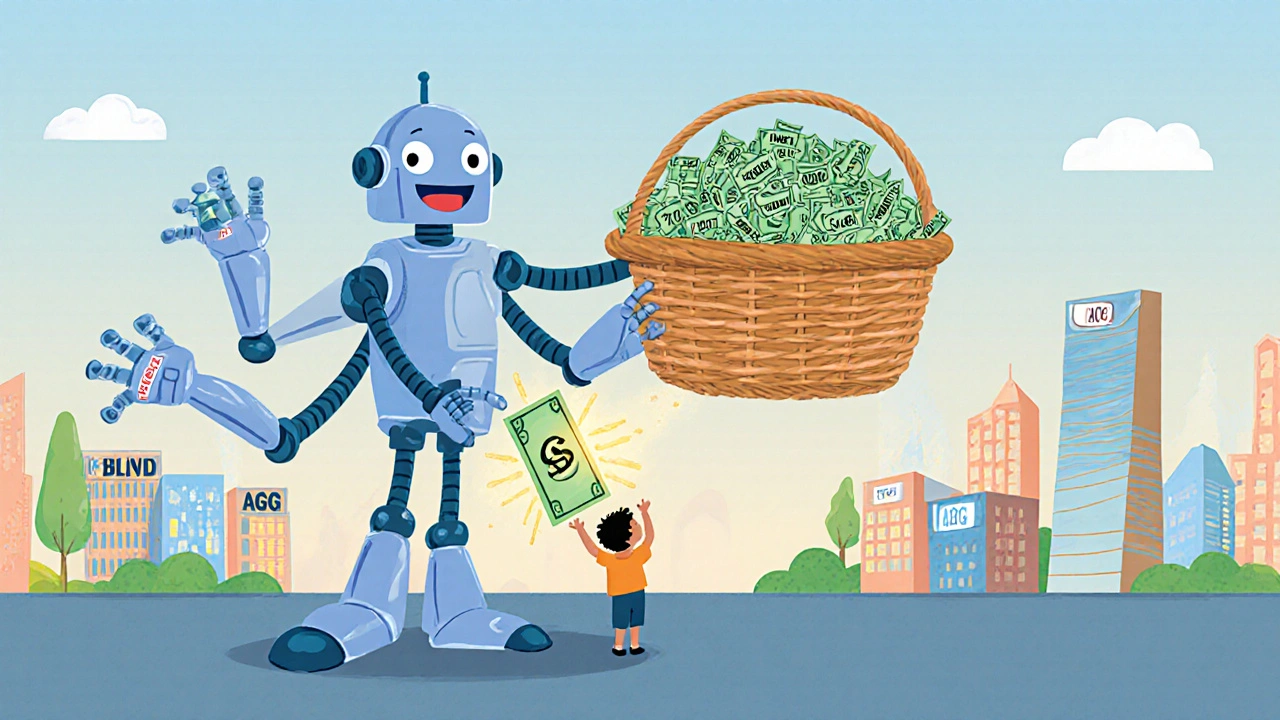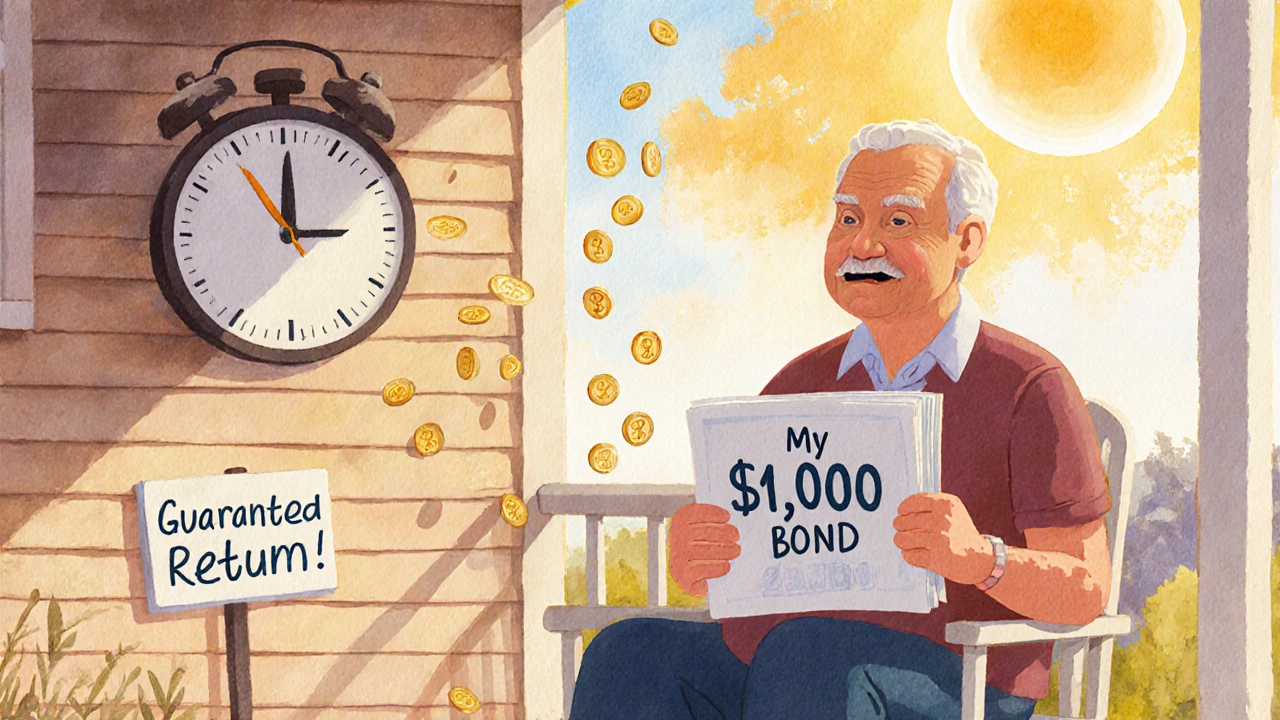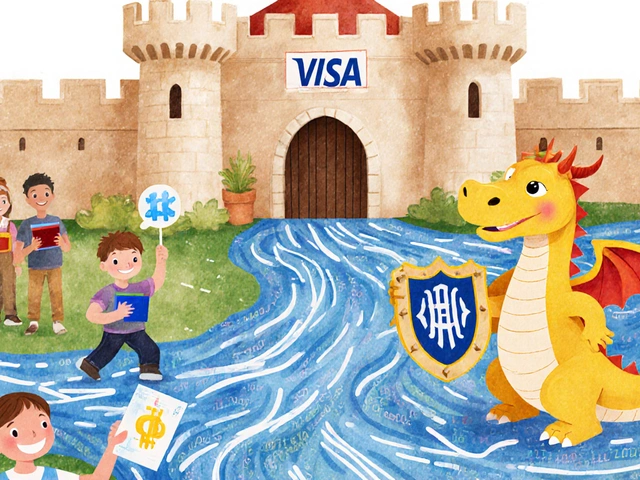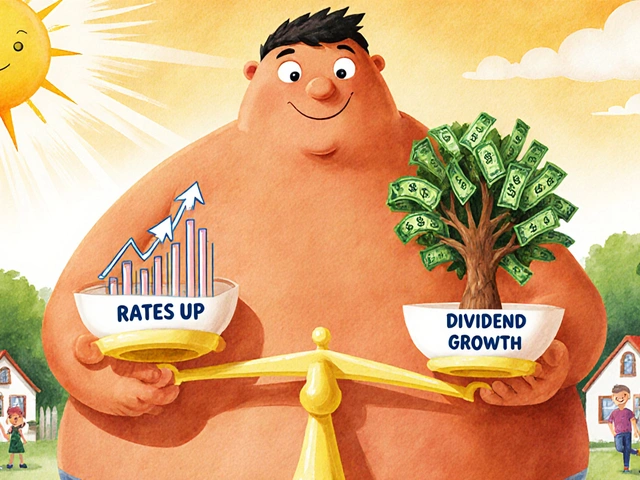Bond Costs Calculator
Compare the true costs of individual bonds versus bond funds based on your investment amount, time horizon, and portfolio size. See how hidden fees and spreads impact your returns.
What’s the real difference between bond funds and individual bonds?
If you’re looking for steady income and lower risk than stocks, bonds are a smart choice. But here’s the question most people don’t ask: Should you buy individual bonds or invest in a bond fund? The answer isn’t one-size-fits-all. It depends on how much money you have, how much time you want to spend managing your investments, and what kind of certainty you need.
Individual bonds are like lending money directly to a company or government. You get paid interest twice a year, and when the bond matures-say, in 10 years-you get your original $1,000 back. No guesswork. Bond funds, on the other hand, are baskets of hundreds of bonds managed by professionals. You buy shares in the fund, and they handle everything. But your value goes up and down every day.
Let’s cut through the noise. Here’s what actually matters when choosing between them.
Control vs. Convenience: The Core Trade-Off
If you hold an individual bond until it matures, you know exactly how much money you’ll get back-even if interest rates spike. That’s powerful. In 2022, when the Fed raised rates to fight inflation, bond funds like Vanguard’s BND dropped nearly 13%. But if you owned a 10-year Treasury bond bought in 2020 and held it to maturity in 2030, you still got your full principal back. No losses. Just waiting.
That certainty is why retirees and conservative investors lean toward individual bonds. You lock in your income and your return. No surprises.
Bond funds don’t offer that. They don’t have a maturity date. Their value moves with interest rates, credit risk, and investor demand. If you sell a bond fund when rates are high, you could lose money. But if you hold it long-term, the income keeps flowing-and you don’t have to worry about picking the next bond.
So: Do you want control over your end date? Go with individual bonds. Do you want to set it and forget it? Bond funds win.
Costs: Hidden Fees vs. Hidden Spreads
People think bond funds are expensive because of their expense ratios. And yes, the average bond mutual fund charges 0.70% a year. ETFs are cheaper-around 0.29%. But that’s not the whole story.
Buying individual bonds comes with hidden costs. Retail investors rarely pay the clean price. You’re buying from a dealer who makes money on the bid-ask spread. For most bonds, that’s 0.5% to 1% per trade. If you buy five bonds, you pay that fee five times. And if you want to sell before maturity? You might get less than you paid, especially if the bond isn’t actively traded.
With bond funds, you pay the expense ratio every year. But you get instant diversification. One $1,000 investment in a bond ETF gives you exposure to hundreds of bonds. To build that same portfolio yourself? You’d need at least $10,000 to $50,000, according to Charles Schwab. And even then, you’d need to monitor each issuer’s credit rating, track maturity dates, and rebalance manually.
Bottom line: Bond funds win on cost efficiency for small to mid-sized portfolios. Individual bonds only make sense if you have the capital and the patience to manage them properly.

Diversification: Can You Really Do It Yourself?
One bond isn’t a portfolio. Ten might be. But to really spread your risk, you need bonds from different sectors, credit ratings, and maturities. That means buying corporate bonds, Treasuries, municipal bonds, maybe even international ones.
Most individual investors can’t do this well. You’d need to buy at least 10-15 bonds just to avoid being overly exposed to one company or industry. And each bond costs $1,000 or more. That’s $15,000 minimum-before fees. And even then, you’re not getting the same level of diversification as a fund holding 2,000+ bonds.
Bond funds solve this instantly. A single ETF like BND holds over 8,000 bonds. You get exposure to U.S. government, corporate, and mortgage-backed securities-all in one purchase. No research, no tracking, no hassle.
For most people, especially those under 70, this is the smarter move. Unless you’re a bond expert with a $100,000+ portfolio, trying to DIY diversification is like trying to build a car from scratch when you can buy a Toyota for $25,000.
Time and Effort: What Are You Really Buying?
Buying individual bonds isn’t just about the money. It’s about your time.
You need to research each issuer. Is General Electric’s credit rating stable? Will the city of Chicago be able to pay its municipal bonds? Is the bond callable? What happens if interest rates keep rising? You need to monitor these things constantly. Morningstar estimates serious individual bond investors spend 5-10 hours a month just managing their holdings.
Bond funds? You check your balance once a quarter. The fund manager handles all the research, rebalancing, and reinvestment. You get the same income stream without the stress.
Think of it this way: Would you rather spend your evenings reading bond prospectuses-or watching your favorite show? For most people, the answer is obvious.
Hybrid Options: The Best of Both Worlds?
What if you want the predictability of individual bonds but the diversification of a fund? There’s a solution: defined-maturity bond ETFs.
Products like Invesco’s BulletShares ETFs work like this: They hold a basket of bonds that all mature in the same year-say, 2028. As each bond matures, the fund pays out the principal to shareholders. At the end of 2028, the fund closes, and you get your cash back.
It’s not perfect. You still pay a small expense ratio (around 0.15-0.25%), and you don’t get the exact same yield as holding a single bond to maturity. But you get diversification, transparency, and a clear end date. And you can buy them like stocks-no minimums beyond the share price.
These funds have grown 22% year-over-year and now hold over $15 billion in assets. That’s not a fluke. More people are realizing they don’t have to choose between control and convenience. You can have both.

Who Should Choose What?
Here’s a simple guide based on your situation:
- Choose individual bonds if: You have $50,000+ to invest, you’re retired or nearing retirement, you want guaranteed principal return at a specific date, and you’re willing to spend time managing your portfolio.
- Choose bond funds if: You’re building wealth, you have less than $50,000, you want instant diversification, you prefer low maintenance, or you’re investing through a 401(k) or IRA.
- Choose defined-maturity ETFs if: You want the structure of a bond ladder without the hassle, you’re saving for a specific goal in 3-8 years (like a house down payment or college), and you want professional management.
And here’s the truth most advisors won’t tell you: For 90% of investors, bond funds are the better choice. Not because they’re perfect, but because they’re practical. They reduce risk, lower costs, and save time-all things that matter more than theoretical perfection.
What About Interest Rates in 2025?
Right now, interest rates are still high compared to the last decade. That’s good news for new bond buyers. You can lock in 4-5% yields on investment-grade bonds. But it also means bond funds are still volatile.
If you’re buying individual bonds today, you’re getting those high yields-and the promise of principal return later. If you’re buying a bond fund, you’re getting those same yields, but your share price might dip if rates rise further.
But here’s the twist: If you hold a bond fund for 5+ years, the higher yields often make up for short-term losses. Vanguard’s research shows that over a 10-year period, bond funds outperformed small 5-bond ladders 82% of the time. Why? Because reinvesting income at higher rates builds compounding power you can’t replicate with a handful of bonds.
So don’t panic because your bond fund dropped last year. If you’re investing for the long haul, that’s normal.
Final Thought: It’s Not About Being Right. It’s About Being Consistent.
The best bond strategy isn’t the one that looks smart on paper. It’s the one you’ll stick with.
Most people who buy individual bonds eventually get overwhelmed. They stop monitoring. They sell early. They get burned by a single default. Meanwhile, the person who bought a low-cost bond ETF and forgot about it? They’re still collecting income, growing their portfolio, and sleeping well.
Investing isn’t about picking the perfect asset. It’s about building a system that works for your life. For most people, bond funds are that system. For a small group with the time, capital, and interest, individual bonds make sense.
Ask yourself: Do I want to be a bond investor-or a bond manager?
Are individual bonds safer than bond funds?
Only if you hold them to maturity and avoid defaults. Individual bonds return your principal at a set date, which feels safer. But if you sell before maturity, you can lose money-just like a bond fund. Bond funds don’t guarantee principal, but they’re diversified, so one bad bond won’t wreck your portfolio. Neither is inherently safer-it depends on how you use them.
Can I lose money in a bond fund?
Yes, if you sell when interest rates are rising. Bond fund prices drop when rates go up because new bonds offer higher yields. But if you hold the fund long-term and reinvest dividends, those higher yields usually make up for the losses. In 2022, the Bloomberg U.S. Aggregate Bond Index lost 13%, but over the next three years, it recovered and delivered strong returns thanks to higher coupon payments.
How much money do I need to start investing in individual bonds?
You can buy a single bond for as little as $1,000. But to build a diversified portfolio, you need at least $10,000-$50,000. That’s because you need bonds from multiple issuers across different sectors and maturities. Most people don’t have the capital or expertise to do this well. Bond funds let you start with $1,000-or even less with ETFs.
Do bond funds pay more than individual bonds?
Not necessarily. The yield depends on the underlying bonds. But bond funds often pay more frequently-monthly vs. semi-annually for individual bonds. And because they reinvest income automatically, you benefit from compounding. Over time, that can mean more total income, especially in rising rate environments.
What’s the best bond fund for beginners?
For most beginners, a total bond market ETF like Vanguard’s BND or iShares Core U.S. Aggregate Bond ETF (AGG) is ideal. They’re low-cost (under 0.10% expense ratio), diversified across government and corporate bonds, and track the broad U.S. bond market. They’re also available commission-free on most platforms. Avoid actively managed bond funds-they charge more and rarely outperform.
Should I use bond funds in my 401(k)?
Absolutely. Most 401(k) plans don’t offer individual bonds. Even if they did, the transaction costs and minimums make them impractical. Bond funds are the only realistic way to add fixed income to your retirement account. Stick with low-cost index bond funds or target-date funds that include them.




It’s not about safety-it’s about *time preference*. Individual bonds are a time capsule: you lock in yield, you get principal back, no surprises. But bond funds? They’re dynamic systems. They’re not meant to be held like heirlooms; they’re meant to be *reinvested*, *compounded*, *adaptive*. The 2022 drop wasn’t a failure-it was a redistribution of yield into higher-coupon bonds. If you’re still treating bonds like savings accounts, you’re missing the point. The market isn’t punishing you-it’s rewarding patience with compounding power you can’t replicate with a 5-bond ladder.
Also, ‘control’ is an illusion. You think you control your bond’s fate? What if the issuer gets acquired? What if the city defaults? What if inflation eats your coupon? The fund doesn’t eliminate risk-it *distributes* it. And distribution is the only rational way to hedge against uncertainty in a world where even Treasuries aren’t truly ‘risk-free’ anymore.
Let’s be real-most people who buy individual bonds are just trying to feel like Warren Buffett while still wearing sweatpants and eating cold pizza at 3 a.m. You think you’re ‘in control’? Nah. You’re just a guy who bought three corporate bonds because he saw a 5.8% yield on a broker’s email and didn’t check if the company still makes fax machines.
Bond funds are the Tesla of fixed income. You don’t need to understand lithium-ion batteries to drive one. You just need to know it gets you from A to B without you having to change the oil. And if you’re spending 8 hours a month reading prospectuses instead of bingeing Stranger Things? You’re not an investor-you’re a glorified bond librarian.
Also, ‘defined-maturity ETFs’? Finally. Someone’s listening. These things are the lovechild of a bond ladder and a vending machine. You set it, you forget it, you get your cash back like a damn vending machine that actually works. Why are we still having this conversation in 2025?
I think bond funds are better for most people. Simple, low cost, no stress. 😊